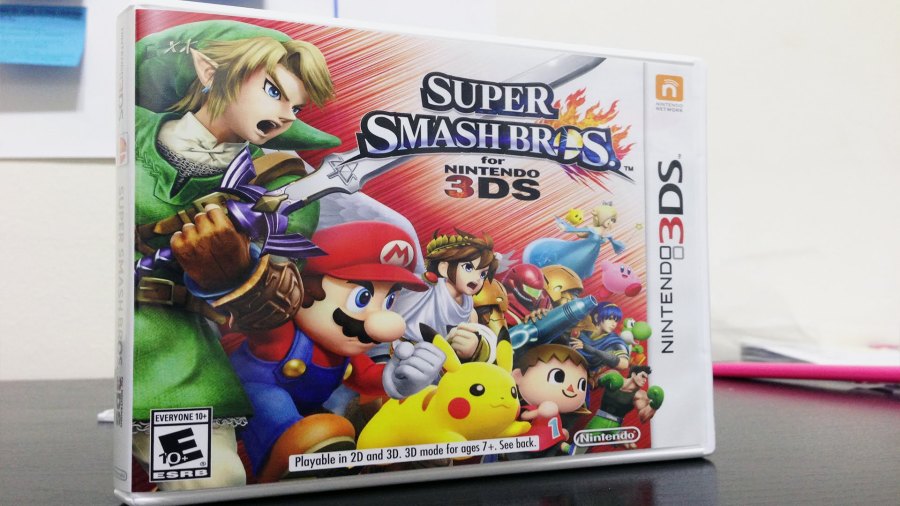Smashing New Ground : Super Smash Brothers 3ds
October 21, 2014
The Super Smash Brothers Series has been around since its initial release of Super Smash Bros. for the Nintendo 64 in 1999 and is an addictive crossover of many different characters from various Nintendo franchises with the inclusion of certain third party characters such as Packman, Mega Man, and Sonic. These games also put a different spin on the classic fighting games due to the fact that instead of trying to defeat a character by lowering their health, you need to knock your opponent(s) of the stage. Knocking an opponent off of the stage is accomplished by dealing the highest percentage of damage to them as you can. Simply put, the higher their percentage, the easier it is to knock them off.
As with every new game in the series, there is a roster of new characters, and this game includes 51 different playable characters. Of these characters, they all have their strong and weak suits. The characters being as balanced as they are is a testament to the experience the game developers have after fifteen years of producing the series. So far the only characters that feel too powerful are Rosalina and Zero-suit Samus and they can even be dealt with by certain characters.
This game features 4 significant changes from the previous installment Super Smash Bros. Brawl in 2008. The first of these is that you can no longer edge hog because now characters can “steal” the ledge that their opponent is holding. The next is that there are no more character transformations simply because the smaller system cannot support them; however, this is a good things because it provides for more “individual characters” that have a move-pool with fully usable attacks. The next is that characters with wings, like Meta knight, cannot glide anymore which makes the game feel a lot more balanced. The last major thing that changed is no more tripping. Tripping was implemented to add some randomness to the game but ultimately failed as many fans of the series reverted back to Super Smash Bros. Melee for the GameCube (2001) as it was the more “competitive” entry in the series. Speaking of competitive play, the new entries of Smash 3ds and later Smash Wii U will be more similar to melee allowing for more competitive gameplay.
Some of the new features included in the game are “Smash Run” where up to four characters run through waves of enemies and collecting powerups for five minutes. After the five minutes are up, there will be a final event, such as a race, that is impacted by the stats that you have collected. There is also an updated version of the classic mode which allows players to bet their coins on certain difficulties to gain more coins, chose their path to progress through the six different stages of the map, and finally defeat the final boss to claim your rewards. The final new feature of the game is the new online play which matches you with random players from around the world. It is split into two areas, “for fun” which is for the casual player and involves the standard two minute matches, and “for glory” which converts each stage to a stage similar to the “final destination” stage with items turned off. This is for the more competitive players and makes finding matches with good players a lot easier.
The elements of the game that I did not like were the fact that the “Smash Run” mode replaced the “Subspace Emissary” mode from Super Smash Bros. Brawl which was a very immersive mode. It consisted of a story of all of the characters meeting up through their own individual journeys. This leads up to all of the characters, heroes and villains, to team up and defeat the final boss and the “God” of Subspace, Taboo. This story was sublime and I hoped that a similar mode would be included in the new games. Perhaps if the “Smash Run” mode allowed a competition between players in real time through online play, it would be more entertaining. The other element that I was not fond of was how limited the soundtrack was for all of the stages. In the previous entry, there were many different tracks for each stage whereas in this game there are only two for each stage.
Despite these flaws, this game is defiantly worth the forty dollar price tag that it asks for. I truly believe that this game is a good improvement from the last game. This stems from the expansive cast, the improved classic mode, and finally the very competitive online modes, especially “for glory”. If you are a fan of the Smash Bros. series and are looking for a game that is more competitive than Super Smash Bros. Brawl, but also contains various improvements that were not present in Super Smash Bros. Melee, than this is a game to add to your collection.



Kaleb Lutton • Dec 11, 2014 at 2:44 pm
Although Super Smash Bros is a great game, it has to compete with the new and improved app stores of various carriers. Such as the App Store (Apple) or Andriod Market. Nintendo has spoken about this rising of mobile games, but hasn’t done much about it. Their efforts in bringing back a popular game of 2001 with a new portable game system is sure to bring in more profits, it won’t surpass the legacy built by Apple or any other cellular provider of this time. Nintendo has to realize that the generation that they target, has involved themselves with the latest iPhone rather than devices like the 3DS. For the owners of Nintendos sake, I say that making a popular game like Smash Bros should be accessible through different app stores.